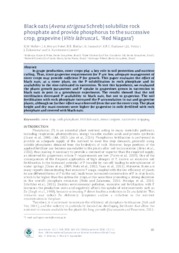Black oats (Avena strigosa Schreb) solubilize rock phosphate and provide phosphorus to the successive crop, grapevine (Vitis labrusca L. "Red Niagara").
Black oats (Avena strigosa Schreb) solubilize rock phosphate and provide phosphorus to the successive crop, grapevine (Vitis labrusca L. "Red Niagara").
Author(s): MELO, G. W. B. de; MORAIS NETO, J. A.; BORBA, D. R.; IWAMOTO, H.; OZELAME, K. P. C.; VIEIRA, J. L.; ZALAMENA, J.; NASCIMENTO JUNIOR, A.
Summary: In grape production, cover crops play a key role in soil protection and nutrient cycling. Thus, since grapevine requirements for P are low, adequate management of cover crops may provide sufficient P for growth. This paper evaluates the effect of black oats, as a cover plant, on the P solubilization in rock phosphate and its availability to the vine cultivated in succession. To test this hypothesis, we evaluated the plants growth parameters and P uptake in grapevines grown in succession to black oats in pots in a greenhouse experiment. The results showed that the soil sterilization decreased P availability to black oats, but not to grapevine. The soil fertilization with rock phosphate increased the P accumulation in oat and grapevine plants, although no further effect was observed from the use the cover crop. The plant height and dry mass contents were higher for grapevine in soils fertilized with rock phosphate and covered with black oats. Keywords: cover crop, rock phosphate, Vitis labrusca, Avena strigose, successive cropping
Publication year: 2018
Types of publication: Journal article
Unit: Embrapa Grape & Wine
Keywords: Avena strigose, Cover crop, Rock phosphate, Successive cropping, Vitis Labrusca
Observation
Some of Embrapa's publications are published as ePub files. To read them, use or download one of the following free software options to your computer or mobile device. Android: Google Play Books; IOS: iBooks; Windows and Linux: Calibre.
Access other publications
Access the Agricultural Research Database (BDPA) to consult Embrapa's full library collection and records.
Visit Embrapa Bookstore to purchase books and other publications sold by Embrapa.

